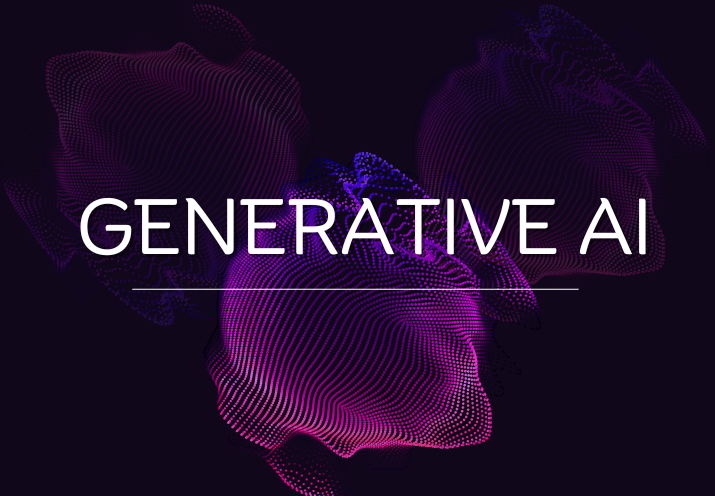The Evolution of Generative AI and its applications
 tagx
tagx
In today's rapidly evolving world of artificial intelligence, generative AI has taken center stage and captured the attention of both technology enthusiasts and industry professionals. With the rise of powerful algorithms and advanced machine learning techniques, applications like ChatGPT have become the talk of the town, generating headlines and sparking conversations worldwide.
Generative AI refers to the field of AI that focuses on creating new, original content rather than simply analyzing existing data. It enables machines to generate realistic and creative outputs, such as text, images, and even music, that mimic human-like behavior and creativity. This breakthrough technology has opened up a world of possibilities across various industries, including content creation, virtual assistants, gaming, and much more.
What is generative AI?
Like other forms of artificial intelligence, generative AI learns how to take actions from past data. It creates brand new content – a text, an image, or even computer code based on that training, instead of simply categorizing or identifying data like other AI. Everyone has days when they’re simply not in the mood to write another email, article, or line of code. Generative AI is there to support your creative process.
Using unsupervised and semi-supervised learning algorithms, generative AI processes enormous amounts of data to generate its own outputs. One example is how with large language models, computer programs can now easily understand texts and generate new content. The neural network that is at the core of generative AI can pick up on the traits of a specific image or text and then exert it when needed.
OpenAI’s ChatGPT is the most well-known of these more expansive Generative AI language models. Given any text prompt, like a phrase or a sentence, ChatGPT returns the next most logical text in the sequence in natural language. Developers can program ChatGPT by showing it just a few examples or prompts. Most people that have interacted with ChatGPT have been fascinated by its ability to write coherent, high-quality language.
How does generative AI work?
Generative AI uses machine learning to process a huge amount of visual or textual data, much of which is scraped from the internet, and then determine what things are most likely to appear near other things. Much of the programming work of generative AI goes into creating algorithms that can distinguish the "things" of interest to the AI's creators—words and sentences in the case of chatbots like ChatGPT, or visual elements for DALL-E. But fundamentally, generative AI creates its output by assessing an enormous corpus of data on which it’s been trained, then responding to prompts with something that falls within the realm of probability as determined by that corpus.
History of Generative AI
The exciting journey of generative AI may be found in the 1950s and 1960s when pioneers of artificial intelligence set out to investigate the possibilities of this developing area. AI researchers initially concentrated on creating rule-based systems that could replicate human thought and decision-making processes. The idea of generative models, however, started to take shape over time and revolutionized a number of industries, including speech recognition, image processing, and natural language processing (NLP).
New generative models like Bayesian networks and Markov models became available at the turn of the millennium, significantly advancing robotics and computer vision. Deep learning's invention and subsequent advancement, however, raised the bar for generative AI. Deep neural network technology has enabled researchers and creators to make significant advances in generative AI. The development of generative adversarial networks (GANs) in 2014, which produced extraordinarily lifelike images, movies, and even sounds that resembled authentic human-generated content, was one significant milestone.
Today, generative AI is being used in a huge variety of applications across many different industries. It has gone beyond what is considered to be traditional art and creativity, allowing for the creation of mesmerizing musical compositions and captivating artwork. Additionally, it has enabled businesses to create fresh goods, enhance healthcare outcomes, and completely alter how we use technology. The field of generative AI is poised to grow even more as technology develops and data availability rises, opening up countless opportunities for creativity and discovery.
Uses of generative models
1. Text generation
This is the application of generative AI that is most responsible for the growing acceptance of AI in content creation. Both individuals and companies frequently employ generative AI technologies like ChatGPT. The time and effort needed to produce new content are decreased by text generation using generative AI models. This is especially useful for marketing efforts where organizations must quickly and effectively produce vast amounts of content.
Moreover, these tools can also help create text-based reports and perform complex business calculations. The image above showcases an example of using chatGPT to calculate the return on ad spending through a prompt. Similarly, you can use it for business reports and calculations.
2. Sentiment analysis
Sentiment analysis is another use of generative AI, which involves text analysis to determine the user’s sentiment or emotion. This can be useful for companies that want to monitor customer sentiment toward their products or services. Sentiment analysis can also be used in social media monitoring, market research, and more. Take an example of a generative AI tool that helps analyze the sentiment behind any written text. It analyzes the syntax and context of the text to provide whether the sentiment is positive or negative.
3. Image generation and enhancement
You can use generative AI for image generation and enhancement. Such generative AI tools use machine learning algorithms to create everything from abstract art to photorealistic landscapes. Moreover, they can also enhance images by improving image quality, such as removing noise or improving color balance.
4. Video creation
Using machine learning algorithms, generative AI tools can also create videos based on your text prompts or data inputs. The video creation feature is particularly useful to advertising, entertainment, and education businesses. Marketers can also use tools based on AI models to create everything from short advertisements to full-length feature films.
5. Code generation
Code generation is another exciting use of this wonderful technology. Generative AI models like GPT-3 can be trained on large amounts of code from various programming languages to create new code. AI-assisted code generation can be used to automate the process of creating website templates, building API clients, or even developing entire software applications. Ultimately, code generated by a generative AI model can speed up the development process and reduce the need for manual coding. A simple example is Open AI’s Playground which lets you create programmable commands through text prompts.
6. Speech to Speech conversion
Speech-to-speech conversion is an impactful feature of most generative AI models. It involves the conversion of one natural language to another in real-time. This can be useful for various applications, such as language translation and interpretation.
7. Text-to-Speech generation
Text-to-speech generation refers to converting written text into spoken audio using natural language processing. This feature can automate tasks such as creating audiobooks, building voice assistants, and more.
8. Audio generation
Using machine and deep learning models, you can use generative AI to create new audio content. With just a few clicks, you can use AI models to create everything from music to sound effects to voiceovers.
9. Synthetic data generation and augmentation
Synthetic data generation involves creating unique data from the input of the original dataset. This is useful when there is not enough data to train a machine-learning model or when it is difficult to obtain new data. Synthetic data can generate images of objects that do not exist in the real world, such as a new type of car or a fictional creature. For example, Dall-E uses multiple models, including a transformer, a latent representation model, and CLIP, to translate English phrases into code. Further, this code generates images and ranks existing images based on how closely they relate to the given phrase.
Data to power your Generative AI
The foundational models used to generate generative AI and the outputs they create need human input to ensure the quality and accuracy of their outcomes, regardless of whether you are utilizing them to alter your business or build generative AI tools. Additionally, generative AI solutions need human experience to create domain-specific solutions such as applications for the legal, medical, and financial sectors.
TagX can assist in ensuring that your Generative AI solutions have the high-quality data required to provide the best experience for your clients. From collecting data of any type speech, text, image, and video - to annotating data at scale, we provide solutions that help manage bias using a diverse group of contributors that maps to your domain. We also provide a 100% guarantee on our data quality to ensure we are meeting your organization’s quality standards.
Subscribe to my newsletter
Read articles from tagx directly inside your inbox. Subscribe to the newsletter, and don't miss out.
Written by
